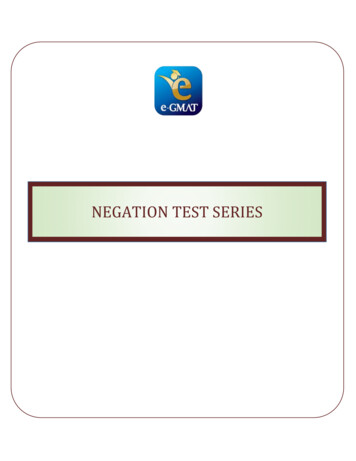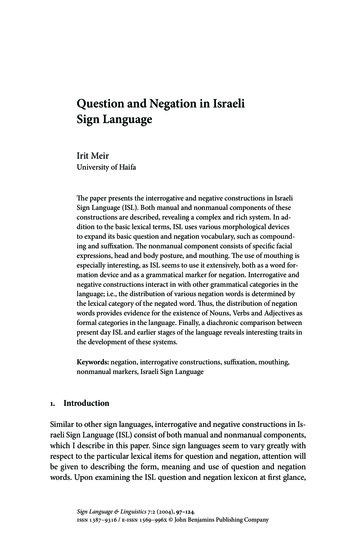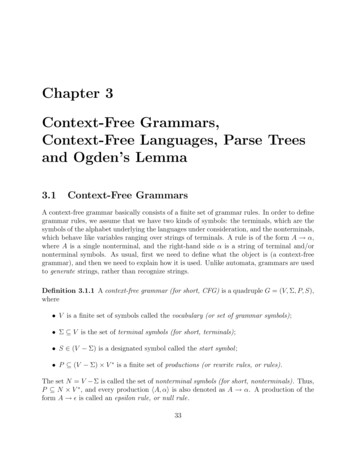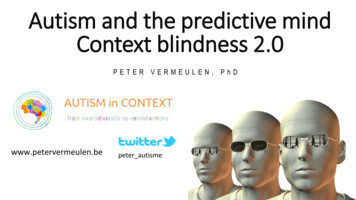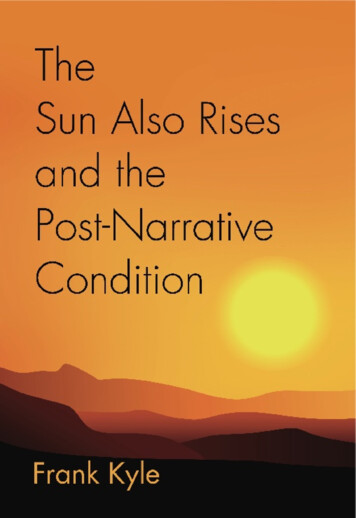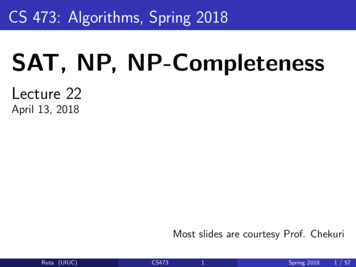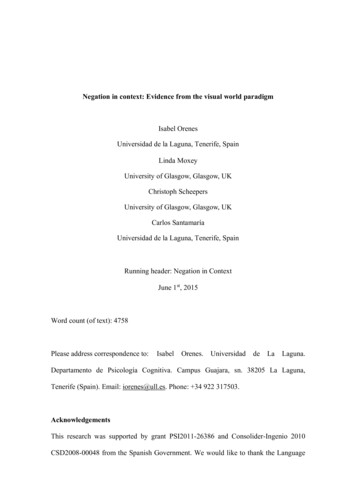
Transcription
Negation in context: Evidence from the visual world paradigmIsabel OrenesUniversidad de la Laguna, Tenerife, SpainLinda MoxeyUniversity of Glasgow, Glasgow, UKChristoph ScheepersUniversity of Glasgow, Glasgow, UKCarlos SantamaríaUniversidad de la Laguna, Tenerife, SpainRunning header: Negation in ContextJune 1st, 2015Word count (of text): 4758Please address correspondence to:IsabelOrenes.UniversidaddeLaLaguna.Departamento de Psicología Cognitiva. Campus Guajara, sn. 38205 La Laguna,Tenerife (Spain). Email: iorenes@ull.es. Phone: 34 922 317503.AcknowledgementsThis research was supported by grant PSI2011-26386 and Consolider-Ingenio 2010CSD2008-00048 from the Spanish Government. We would like to thank the Language
Negation in Contextgroup of the University of Glasgow and David Beltrán for their suggestions andcomments.AbstractLiterature assumes that negation is more difficult to understand than affirmation, butthis might depend on the pragmatic context. The goal of this paper is to show thatpragmatic knowledge modulates the unfolding processing of negation due to theprevious activation of the negated situation. To test this, we used the visual worldparadigm. In this task, we presented affirmative (e.g., her dad was rich) and negativesentences (e.g., her dad was not poor) while viewing two images of the affirmed anddenied entities. The critical sentence in each item was preceded by one of three types ofcontexts: an inconsistent context (e.g., She supposed that her dad had little savings) thatactivates the negated situation (a poor man), a consistent context (e.g., She supposedthat her dad had enough savings) that activates the actual situation (a rich man), or aneutral context (e.g., her dad lived on the other side of town) that activates neither of thetwo models previously suggested. The results corroborated our hypothesis. Pragmaticsis implicated in the unfolding processing of negation. We found an increase in fixationson the target compared to the baseline for negative sentences at 800 ms in the neutralcontext, 600 ms in the inconsistent context, and 1450 ms in the consistent context. Thus,when the negated situation has been previously introduced via an inconsistent context,negation is facilitated.Keywords: negation; context; visual world paradigm.2
Negation in ContextIntroductionThe comprehension of language is context-dependent: its content depends not only onthe syntactic and semantic properties of the types of expressions used, but also on factsabout the situation in which the expressions are used (Stalnaker, 1998). Negativesentences do not point to the actual situation but to what is not the case. As aconsequence, in their comprehension we must figure out what the speaker is referringto, and pragmatics becomes crucial. If someone tells us that their car is not red thereshould have been a reason to presume (or speculate) that it is red. Otherwise the uttererwould have referred to the actual color of the car. In fact, individuals seem to useaffirmation to communicate as default, but negation is often used in some specificcontexts, and outside of these contexts negation is difficult to understand (Khemlani,Orenes, & Johnson-Laird, 2012).The representation and processing of negation has important implications formemory and language theories. Research has shown that negative sentences are moredifficult to comprehend than their corresponding affirmatives: people take longer tounderstand negation and are likely to make more mistakes in processing negation (seeCarpenter & Just, 1975; Clark & Chase, 1972; Mayo, Schul, & Burnstein, 2004;Trabasso, Rollins, & Shaughnessy, 1971; Wason & Johnson-Laird, 1972; Wason &Jones, 1963). Furthermore, negated concepts are less well recalled than affirmative ones(Fillenbaum, 1966; Lea & Mulligan, 2002; MacDonald & Just, 1989). These resultswould indicate that negative and affirmative information is processed and representeddifferently.3
Negation in ContextAmong other explanations, Kaup, Lüdtke & Zwaan (2006) proposed a two-stepsimulation hypothesis to understand negation. For a negative such as the door is notopen for example, individuals would first represent the negated situation; an open door;and then the actual situation: a closed door. For an equivalent affirmative (e.g., the dooris closed), the actual situation is directly available: a closed door (Kaup, Zwaan, &Lüdtke, 2007; Zwaan, Stanfield, & Yaxley, 2002). This two-step processing has beenfound in metaphors (Hasson & Glucksberg, 2006), quantifiers (Moxey & Sanford(1987), and counterfactuals (Byrne, 2005) among others. Within this framework, it hasalso been proposed that rather than a two-step sequence of static images, negationwould be represented by the continuous-trajectory derivative over time in a perceptualsimulation (Anderson, Huette, Matlock, Spivey, 2010; Huette, & Anderson, 2012;Huette, Anderson, Matlock, & Spivey, 2011; Tian, Breheny, & Ferguson, 2010).Despite this, many studies have also shown that when negation is presented in anadequate context, it can be similar to affirmation (Dale & Duran, 2011; Givon, 1978;Glenberg, Robertson, Jansen & Johnson-Glenberg, 1999; Johnson-Laird & Tridgell,1972; Nieuwland & Kuperberg, 2008; Strawson, 1952; Wason, 1972). The question thatremains unsolved to date is what makes a context ‘adequate’ for understandingnegation. Wason (1965) proposed that negation is easier to understand when it is used tocommunicate deviations from expectations (see also Givon, 1978). In this case,negation may be easier to understand because the negated situation has been constructedalready (Khemlani et al., 2012). For example, Lüdtke & Kaup (2006) presented acontext (e.g., that a boy s T-shirt is dirty after he played outside in the backyard) thatactivates the negated situation (e.g., a dirty t-shirt) previously, and the processing ofnegation (e.g., the T-shirt was not dirty) was facilitated. It seems then, that the difficultyof negation is due to the change of attention (or deviation) from the negated concept4
Negation in Contexttoward the actual situation. However, when the negated concept is previously activatedin an adequate context, its processing is facilitated.The visual world paradigm allows us to study the unfolding process ofcomprehending negation. In a typical visual world task verbal and visual inputs arepresented simultaneously while the participants’ eye movements are recorded. Eyemovements provide an index of real time processing that most other methodologies donot offer, and they are sensitive to subtle aspects of language, attention and memory(Allopenna, Magnuson, & Tanenhaus, 1998; Duñabeitia, Avilés, Afonso, Scheepers &Carreiras, 2009; Rayner, 1998). From the literature, it is expected that when somethingis heard, it is processed and attended to automatically. At the same time, if the object isvisible, the eyes begin to move towards the corresponding object (Cooper, 1974;Tanenhaus, Spivey-Knowlton, Eberhard & Sedivy, 1995). It follows that when peopleare exposed to negative assertions in a visual world paradigm, they will look morefrequently at the most active information in working memory.Our main goal in the present study is to test the role of context in the process ofunderstanding negation. Our hypothesis is that certain contexts can activate the negatedconcept before the negation is encountered. This is consistent with Khemlani et al.(2012) who, based on Wason (1965), pointed out that negation is easier when thenegated situation has been constructed previously within the context. First, we presentedaffirmative (e.g., her dad was rich) and negative sentences (e.g., her dad was not poor)in a neutral context (e.g., her dad lived on the other side of town), and we expected tofind the classical effect of negation: negative sentences takes longer to process thanaffirmative sentences. This effect could be reduced in a context in which the negatedsituation has been constructed previously, what we have labeled an inconsistent context(e.g., She supposed that her dad had little savings). This context activates the negated5
Negation in Contextsituation (e.g., her dad was poor). In a third condition, we presented a consistent contextsentence (e.g., She supposed that her dad had enough savings) that activates the actualsituation (e.g., her dad was rich) followed by the affirmative (e.g., her dad was rich) orthe negative sentence (e.g., her dad was not poor). While the affirmative statement isdirectly understood after the context sentence, understanding of the negative statementrequires listeners to represent a rich man after hearing the context, and then a poor manafter hearing negation (not poor), and finally the rich man again. These extra stepsrequired to understand negation will take time compared to affirmation. Therefore, theconsistent context is expected to be the most difficult one for negation (see JohnsonLaird & Tridgell, 1972). The extra processing in the consistent context condition shouldbe reflected in the eye movement because people need to change their focus of attentiontwice from the rich man to the poor man, and from the poor man to the rich man in ourexample.MethodsParticipantsFifty native Spanish speakers from the University of La Laguna, Tenerife (Spain),participated in the experiment in exchange for course credits. All of them had normalvision or wore soft contact lenses or glasses.MaterialsForty-eight experimental vignettes of simple events were heard. The first two sentencesin each vignette described a general situation (e.g., Veronica needed a new car for work.She wondered whether her dad could help her financially). The second sentence in each6
Negation in Contextvignette presented a context. This sentence was always stated as a presupposition byusing reported speech forms (he supposed, she thought, etc.) so that there was no apriori contradiction with the subsequent affirmative or negative sentences. The contextcould be consistent (e.g., She supposed that her dad had enough savings), inconsistent(e.g., She supposed that her dad had little savings) or neutral (e.g., her dad lived on theother side of town) with respect to the target part of the story in the final sentence thatconsisted of an affirmative (e.g., her dad was rich) or a negative sentence (e.g., her dadwas not poor).“(Figure 1 about here)”For each trial, a different display with two images appeared on the screen. Forexample, an image of a poor man on the left and a rich man on the right (see Figure 1).The position of each image was counterbalanced across conditions. The order of thematerials was randomized, and 12 versions of the full set of materials were prepared:each context (consistent, inconsistent, and neutral) was combined with the two types ofsentences (affirmative and negative) and the two poles of the adjective contraries (e.g.,poor-rich), so that only one of the 12 possible versions of each experimental itemoccurred in each presentation file (see Table 1). In total, there were 8 experimental trialsin each of six conditions: consistent-affirmative, consistent-negative, inconsistentaffirmative, inconsistent-negative, neutral-affirmative, and neutral-negative. For alltrials, the analysis of fixations was time-locked to the onset of the critical adjective inthe target sentence, that is, ‘rich’ in an affirmative sentence such as her dad was richand ‘poor’ in a negative sentence such as her dad was not poor.7
Negation in Context“(Table 1 about here)”Apparatus and ProcedureParticipants’ eye movements were recorded at a rate of 500 Hz using an SR ResearchEyeLink II head-mounted eye-tracker connected to a 21-inch color CRT for visualstimulus presentation. Procedures were implemented in SR Research ExperimentBuilder. Calibration and validation procedures were carried out at the beginning of theexperiment and repeated several times per session. Trials started with the presentationof a central fixation dot for drift correction while participants listened to the generalsituation and the context (consistent, inconsistent, or neutral). After that, a display withtwo images appeared for 2 seconds and then the story finished with the presentation ofan affirmative or negative sentence that was the target. The trial concluded with theappearance of a written question (e.g. did Veronica need a new car?) which participantshad to answer by pressing either a “yes” or a “no” button. There was a practice block offour trials before the experiment proper started. The entire experiment lastedapproximately 30 minutes.ResultsThe eye-movement data generated by the EyeLink system were analyzed as follows.First, bitmap templates were created for identifying regions of interest in each display(e.g., a rich and a poor man). The object regions were defined in terms of rectanglescontaining the relevant objects; fixations landing within the perimeters of theserectangles were coded as fixations on the relevant objects. The output of the eye-trackerincluded the x- and y-coordinates of participant fixations, which were converted into8
Negation in Contextregion of interest codes using the templates. Fixations shorter than 80 ms (accountingfor ca. 0.2% of all fixations) were pooled with preceding or following fixations if theywere within 0.5 degrees of visual angle. Times for blinks were added to the immediatelypreceding fixations. The analyzed time period was from the onset of the target to 3000ms after the target word (as established on a by-trial basis). This time window waschosen to guarantee there was enough time to comprehend negations (e.g., Kaup,Lüdtke, & Zwaan, 2006; Lüdtke, Friedrich, Filippis & Kaup, 2008). This period wasfurther divided into 50 ms time slots. For each time slot, the number of fixations on thetarget image was divided by the sum of the fixations on the target and competitorimage, yielding fixation probabilities for the target image. Since eye-blinks, off-screenfixations, and empty-space fixations together accounted for no more than 6% of the dataat any given point in time, proportions of looks to the competitor image were more orless complementary to proportions of looks to the target image.“(Figure 2.1 about here)”Figure 2 depicts probabilities of fixations on the target region of interest as afunction of time and context. Figure 2.1 corresponds to the neutral context, wherepeople heard a context that was not related to the critical sentence (or target). Forexample, ‘Her dad lived on the other side of town’. In this case the context does notfavour any of the images that are shown on the screen, therefore listeners initially lookat both images equally often. When participants listened to the affirmative sentence, e.g.‘Her dad was rich’ and the negative sentence, e.g. ‘Her dad was not poor’, fixationprobabilities on the target interpretation image increased (e.g. the rich man), but thisincrease was earlier for affirmative sentences than for negative sentences.9
Negation in Context“(Figure 2.2 about here)”Figure 2.2 shows the data for the inconsistent context condition, whereparticipants heard the critical affirmative or negative sentence following a context thatwas inconsistent with what was mentioned in the critical sentence. As can be seen,people started to look at the target interpretation image earlier in the affirmative than inthe negative sentence condition.“(Figure 2.3 about here)”Figure 2.3 shows the data for the consistent context condition. In this context,affirmative (e.g., her dad was poor after She supposed that her dad had little savings),and negative sentence (e.g., Her dad was not poor after She supposed that her dad hadenough savings) ultimately led to the same pattern of fixations. The difference is in thetiming: participants fixate on the target more quickly following an affirmative comparedto a negative statement.T-test against baselineTo avoid problems inherent to proportional data, participant and item averages werearcsin-transformed prior to t-test comparisons. Given that 180-200 ms are usuallyassumed to account for saccade programming (Martin, Shao, & Boff, 1993), the meanof the first time-region (0 - 100 ms) was considered to be the baseline and was used toconduct statistical comparisons against means on each time point until 3000 ms later(for a similar method, see Huettig & Altmann, 2010). This correction to baselineallowed us to control for any bias in the pattern of fixations on figures caused by the10
Negation in Contexttype of context. A False Discovery Rate (FDR) thresholding procedure was used toeffectively control for the type 1 error due to multiple comparisons (58 for eachcondition; Genovese, Lazar, & Nichols, 2002). We eliminated one subject due toproblems in the recording of her eye movements.In the neutral context, there was an increase in fixation on the targetinterpretation for affirmative sentences at 500 ms (pFDRcorr1 .011(subject analysis);pFDRcorr2 pFDRcorr1 .007; pFDRcorr2 .001). In the inconsistent context, the significantdifferences with respect to the baseline started at 500 ms for affirmative sentences(pFDRcorr1 .016; pFDRcorr2 .002) and at 600 ms for negative sentences(pFDRcorr1 .014; pFDRcorr2 .025). It is important to keep in mind that whileaffirmative sentences are processed similarly in both contexts, negative sentences arefacilitated in the inconsistent context when the negated situation is already constructed.In the consistent context condition, there was an increase in fixation on the targetinterpretation starting at 650 ms (pFDRcorr1 .002; pFDRcorr2 .006) for affirmativesentences, while there was a decrease in fixation on the target interpretation at thebeginning, at the temporal point of 800 ms, (pFDRcorr1 .048; and between 450 and700 ms in the item analysis: pFDRcorr2 .028) and then there was an increase infixation starting at 1450-1550 ms (pFDRcorr1 .039; and from 2000 ms in the itemanalysis pFDRcorr2 .047) for negative sentences. In this last context, we can see thatparticipants needed to build first the negated situation around 800 ms because it has notbeen constructed previously and then, the actual situation around 1450 ms. Inconclusion, pragmatic information clearly has an influence on the process ofunderstanding negations.11
Negation in ContextThe growth-curve analysisThis analysis is a multilevel regression technique designed for analysis of time coursewith orthogonal power polynomials (see Mirman, Dixon, & Magnuson, 2008). First, wemodeled the effect of polarity separately for each verbal context. With this method, wecan examine if the differences between affirmative and negative sentences lay at theintercept (which would reflect differences between overall fixation ratios), at the linearterm (which would reflect differences at a monotonic change in fixation ratios), and atthe quadratic term (which would reflect differences at the symmetric rise and fall rate offixation ratios around a central inflection point). Second, we modeled whetherdifferences between affirmative and negative sentences varied across contexts. Wereport a deviance statistic, often called -2LL (minus 2 times the log-likelihood), thechanges in deviance (AD), and the p-value. The change in deviance allows us to testwhether including the parameter increases the fit of the model (see Table 2).The results of Table 2 show that affirmative and negative sentences differedsignificantly across contexts. In the neutral context, there was a significant effect at theintercept, which indicates that fixation on the target interpretation was higher foraffirmative sentences than for negative sentences. There was also a difference at thelinear term (slope), reflecting a different increase in fixation for affirmative andnegative sentences. That is, while affirmative sentences increased at 500 ms, negativesentences increased at 800 ms. The inconsistent context had significant effects on thelinear and the quadratic terms. These effects reflect that affirmative sentences had asteeper slope, while affirmative sentences increased at 500 ms, negative sentencesincreased at 600 ms. The largest effect was on the quadratic term. That is, the difference12
Negation in Contextbetween affirmative and negative sentences was primarily in the rise and fall of thefixation probability curves. Figure 2.2. shows that the temporal location of the peak isaround 1000 ms for affirmative sentences and 1500 ms for negative sentences. In theconsistent context, we only found differences between affirmative and negativesentences in the quadratic term. This result reflects differences in the rise and fall offixation proportions between affirmative and negative sentences. Figure 2.3. shows thatparticipants decreased their attention on the target around 400 ms (the peak) and then,they increased their attention, with the temporal location of the peak around 700ms foraffirmative sentences. However, the proportions are different for negative sentences,where the lowest peak was around 700 ms and the highest peak was around 2500 ms.On the other hand, the differences between affirmative and negative sentences variedacross contexts in the quadratic term. This indicates that the main difference betweencontexts is in the distribution proportion rather than the intercept or slope. To sum up,these results indicate that affirmative and negative sentences result in different targetfixation profiles across all contexts.“(Table 2 about here)”DiscussionThe results are consistent with the view that pragmatic knowledge influences theprocess of understanding negation. We found an increase in fixation compared to thebaseline on the target for negative sentences at 800 ms in the neutral context condition,600 ms in the inconsistent context condition, and 1450 ms in the consistent contextcondition. These differences are smaller for affirmative sentences, at around 500 ms in13
Negation in Contextthe neutral and inconsistent context condition, and at around 650 ms in the consistentcontext condition. Therefore, it seems that pragmatic information, as manipulated in thisexperiment, modulates the unfolding processing of negation more than of affirmation.On the other hand, our results show that negative sentences are always slower toprocess than affirmation regardless of context. This finding is at odds with many studiesthat indicate that negation and affirmation can be processed in a similar way (Dale &Duran, 2011; Givon, 1978; Glenberg et al., 1999; Johnson-Laird & Tridgell, 1972;Nieuwland & Kuperberg, 2008; Strawson, 1952; Wason, 1972). That is, while ourresults have shown that pragmatic information can indeed aid the processing ofnegation, the latter still remained more difficult to process than affirmation regardless ofcontext. This could suggest that, compared to other methods, visual world eye-trackingdata may be more sensitive to subtle, context-independent processing differencesbetween affirmative and negative sentences.In the neutral context, we found the classical effect of negation (see Carpenter &Just, 1975; Clark & Chase, 1972; Mayo et al., 2004; Trabasso et al., 1971; Wason &Johnson-Laird, 1972; Wason & Jones, 1963). Growth-curve analysis revealed an effectat the intercept, indicating that fixations on the target were more likely (within theconsidered time period) for affirmative sentences than for negative sentences. Moreimportantly, there was also a difference in the linear term, reflecting differentialincreases in target fixation probability over time for affirmative (at ca. 500 ms) andnegative sentences (at ca. 800 ms). That is, participants were mainly slower to attend tothe target in negative than in affirmative sentences (see also: Orenes, Beltrán, &Santamaría, 2014). This finding could be related to the fact that negated concepts areless readily recalled than affirmative ones (Fillenbaum, 1966; Lea & Mulligan, 2002;MacDonald & Just, 1989).14
Negation in ContextIn the consistent context, participants heard the negative sentence Her dad wasnot poor after hearing She supposed that her dad had enough savings. In this case,participants switched their attention from the image of the rich man (after hearing thecontext) toward the image of the poor man (after hearing negation) 800 ms after hearingthe critical word (‘poor’). After that, they switched their visual attention again from thepoor man towards the rich man (at around 1450 ms). These two computations take extratime (see also Johnson-Laird & Tridgell, 1972). It is interesting to note that acomparable increase in the number of fixations on the target started at around 650 msfrom critical word-onset in affirmative sentences. This delay in comparison to the othercontext conditions may be due to the target not being very informative, that is, itconfirms information already suggested by the context. As the theory of relevancepurports, communication must be relevant (Grice 1961; Wilson & Sperber, 2004);however, in the consistent context condition, after listening to for example, Shesupposed that her dad had little savings, listeners already inferred that her dad musthave been poor, thus when they actually heard the affirmative Her dad was poor, thisinformation was less relevant in the sense that participants already knew it. As a result,(re-)inspecting the target was somewhat delayed.The process of understanding negation is facilitated when the negated situationhas been presented previously (Givon, 1978; Khemlani et al., 2012; Lüdtke & Kaup,2006; Wason, 1965), but it is still more difficult than understanding affirmation. Thissuggests that the differences between negative and affirmative sentences are not purelypragmatic. In the inconsistent context, in which the negated situation was presentedpreviously, we found differences in the linear term, reflecting a different increase infixation for affirmative (at around 500 ms) and negative sentences (at around 600 ms).There was also a difference in the quadratic term, reflecting differences at rise and fall15
Negation in Contextin fixation proportions between affirmative and negative sentences. That is, the highestpeak happened around 1000 ms for affirmative sentences ms and around 1500 ms fornegative sentences.The advantage of using the visual world paradigm is that this method allows usto see how people update their current interpretations online while processing negationwithin different contexts. For example, when participants were focused on the poor manimage after hearing the inconsistent context, and then they heard: he was not poor, theyswitched toward the target image (the rich man) at 600 ms. However, as they werefocused on both images equally often in the neutral context, when they heard: he wasnot poor, they switched toward the rich man target image with a delay compared to theinconsistent context, at 800 ms. The visual world paradigm was therefore sensitiveenough to detect the effect of pragmatic.It is interesting to note that affirmative and negative sentences were easier whenthey were used to deny a false belief (inconsistent context) than when no prior beliefswere established (neutral context) because previous literature suggests that once beliefsare held, they should be difficult to change. That is, people tend to maintain their beliefseven when faced with evidence to the contrary (Khemlani & Johnson-Laird, 2012;Orenes, Navarrete, Beltrán & Santamaría, 2012). Based on this premise, one couldpredict that when people listen to a context that is inconsistent with the target, the lattermust be processed more slowly (see Ferguson, Sanford, & Leuthold, 2008). However,our results show that both affirmative and negative sentences are processed morequickly in the inconsistent context (when they are used to deny or change a belief) thanin a neutral context. This could probably be due to a priming effect. In our experiment,we presented a context that led to a prediction, for example whether the criticalprotagonist (‘her dad’) was rich or poor. Given the context She supposed that her dad16
Negation in Contexthad little savings, for example, there is a prediction that ‘her dad’ is poor. In theinconsistent condition, this was then rejected with ‘her dad was not poor’. The neutralcontext Her dad lived on the other side of town makes no such prediction about thecritical protagonist’s financial status. As Khemlani and collaborators (2012) pointedout, individuals should find it easier to understand a negation if they have alreadyconstructed the models of the corresponding affirmative assertion.In conclusion, pragmatic information influences the processing of negation morethan affirmation, especially when the negated situation is already constructed, but itdoes not explain all of the difference in difficulty between negative and affirmativesentences. Negation is, clearly, a complex phenomenon and further research should beconducted to its apprehension.ReferencesAllopenna, P.D., Magnuson, J.S., & Tanenhaus, M.K. (1998). Tracking the time courseof spoken word recognition using eye movements: evidence for continuousmapping models. Journal of Memory and Language, 38, 419-439.Anderson, S., Huette, S., Matlock, T., & Spivey, M. (2010). On the temporal dynamicsof negated perceptual simulations. In F. Parrill, V. Tobin & M. Turner (Ed.),Meaning Form and Body. Stanford University, California: CSLI Publications(pp. 1-20).Byrne, R.M.J. (2005). The rational imagination: How people create alternatives toreality. CA: MIT Press.Carpenter, P. A., & Just, M. A. (1975). Sentence comprehension: A psycholinguisticprocessing model of verification. Psychological Review, 82, 45-73.17
Negation in ContextClark, H. H., & Chase, W.G. (1972). On the process of comparing sentences againstpictures. Cognitive Psychology, 3, 472-517.Cooper, R. M. (1974). The control of eye fixation by the meaning of spoken language: anew methodology for the real-ti
Negation in Context 6 situation (e.g., her dad was poor). In a third condition, we presented a consistent context sentence (e.g., She supposed that her dad had enough savings) that activates the actual situation (e.g., her dad was rich) followed by the affirmative (e.g., her dad was rich) or the negative sentence (e.g., her dad was not poor).While the affirmative statement is
